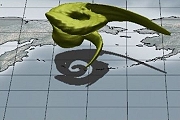Volcanic Ash Forecast with ICON-ART
Many might still remember the eruption of the Eyjafjallajökull volcano on Iceland in 2010. At that time, authorities had to close the airspace over large areas of central and northern Europe for several day, as volcanic ash imposes a great hazard on aircrafts. Besides that, particles from volcanic eruptions interact with radiation and cloud formation in the atmosphere and, hence, influence weather and climate.
Volcanic eruptions can release large amounts (in the order of several Tg) of very fine ash particles and volcanic gases, such as SO2 into the atmosphere. SO2 undergoes chemical reactions, which transform it into sulfate particles. These particles are transported together with the ash by wind and are dispersed within the atmosphere. Ash and sulfate interact with each other or other trace elements in the atmosphere. This so-called aging process generates an internally mixed aerosol. Such aging not only changes the chemical composition of particles, but also the optical properties, especially the absorption and scattering behavior in the near and mid infrared bands.
To avoid closures of airspace over large areas after volcanic eruptions it is necessary to have a reliable forecast of volcanic aerosol dispersion. In our “Aerosols, Trace Gases and Climate Processes” research group we improve the ICON-ART modeling system in order to prepare for the next big volcanic eruption in Europe. In this context, we implemented different aging processes for aerosols as well as their modified optical properties into ICON-ART. Based on these improvements it is possible to directly compare model results with measurements, which are mainly derived from satellite and lidar data.
One event, which allows us to test our developments by comparison to measurements, happened on a Russian island in the northwest Pacific on 21 June 2019. On this island, the Raikoke volcano erupted at around 6pm (UTC). It emitted 1.5 Tg SO2 and 1.9 Tg of very fine ash particles up to 14 km altitude into the atmosphere over a period of 9 hours. It was one of the biggest volcanic eruptions during the last 30 years. The dispersion of the volcanic aerosol and gas plume has been simulated with ICON-ART. Exemplarily the dispersion of the SO2 cloud is shown in the animation. The animation displays an isosurface of a constant concentration of 100 µg SO2 per kg air. It visualizes impressively the complex dispersion behavior of the emitted gas by the occurring flow situation.
Workinggroup: Aerosols, Trace Gases and Climate Processes

